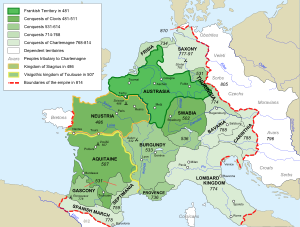Saxon Wars
| Saxon Wars | |||||||
|---|---|---|---|---|---|---|---|
 Map of the Frankish Empire from 481 to 814 |
|||||||
|
|||||||
| Belligerents | |||||||
| Carolingian Empire | Saxons | ||||||
| Commanders and leaders | |||||||
|
Charlemagne, Chamberlain Adalgisile †, Constable Geilo †, Count Palatine Worad †, Count Theodoric † |
Widukind |
||||||
The Saxon Wars were the campaigns and insurrections of the more than thirty years from 772, when Charlemagne first entered Saxony with the intent to conquer, to 804, when the last rebellion of disaffected tribesmen was crushed. In all, eighteen battles were fought in what is now northwestern Germany. They resulted in the incorporation of Saxony into the Frankish realm and their forcible conversion from Germanic paganism to Catholicism.
Despite repeated setbacks, the Saxons resisted steadfastly, returning to raid Charlemagne's domains as soon as he turned his attention elsewhere. Their main leader, Widukind, was a resilient and resourceful opponent and accepted a peace offering from Charlemagne in a perilous situation, not losing his face and preventing Charlemagne from continuing a bothersome war. This agreement saved the Saxons' leaders' exceptional rights in their homeland. Widukind was baptized in 785 and buried in the only Germanic church without a spire.
The Saxons were divided into four subgroups in four regions. Nearest to the ancient Frankish kingdom of Austrasia was Westphalia, and farthest away was Eastphalia. In between these two kingdoms was that of Engria (or Engern) and north of these three, at the base of the Jutland peninsula, was Nordalbingia.
In mid-January 772, the sacking and burning of the church of Deventer by a Saxon expedition was the Casus belli for the first war waged by Charlemagne to the Saxons. It began with a Frankish invasion of Saxon territory and the subjugation of the Engrians and destruction of their sacred symbol Irminsul near Paderborn in 772 or 773 at Eresburg. Irminsul may have been a hollow tree trunk, presumably representing the pillar supporting the skies—similar to the Nordic tree Yggdrasil and apparently a common belief among the Germanic peoples. Charlemagne's campaign led all the way to the Weser River and destroyed several major Saxon strongholds. After negotiating with some Saxon nobles and obtaining hostages, Charlemagne turned his attention to his war against the Lombards in northern Italy; but Saxon free peasants, led by Widukind, continued to resist and raided Frankish lands in the Rhine region. Armed confrontations continued unabated for years.
...
Wikipedia
